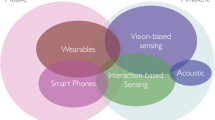Abstract
Tracking indoor locations of residents is a prerequisite of accurate monitoring and advanced understanding of human activities in smart homes. Without using any indoor video surveillance devices in terms of preserving privacy and security, majority of existing approaches often utilise wearable BLE/RFID sensor tags to track locations of residents through analysing variations of received signal strength and angle of sensor tags. In a multi-residential environment, these tags can also be used as unique identifiers to help distinguish individuals. However, the extra burdens of remembering and wearing sensor tags all day along restrict them to be widely accepted by senior communities, let alone by people with neurodegenerative diseases. In this study, we propose a novel indoor tracking technique for smart homes with multiple residents, through relying only on non-wearable, environmentally deployed sensors such as passive infrared motion sensors. We design a multi-tracker system that uses multiple, independent probabilistic models, such as Naive Bayes and hidden Markov model, to track different residents’ movements separately. We evaluate our tracking technique on real sensor data acquired from a dual-occupancy smart home in our clinical trials. The experiment results, through comparing with location details acquired by wearable tags, demonstrate that our proposed technique is a simple yet feasible solution to tracking multi-residents’ indoor movements.
Access this chapter
Tax calculation will be finalised at checkout
Purchases are for personal use only
Similar content being viewed by others
References
Ayuningtyas, C., Leitner, G., Hitz, M., Funk, M., Hu, J., Rauterberg, M.: Activity Monitoring for Multi-inhabitant Smart Homes. SPIE Newsroom, Den Haag (2014)
Chiang, Y.-T., Hsu, J.Y.-J., Lu, C.-H., Fu, L.-C., Hsu, J.Y.-J.: Interaction models for multiple-resident activity recognition in a smart home. In: Proceedings of the 2010 IEEE/RSJ International Conference on Intelligent Robots and Systems (IROS), pp. 3753–3758. IEEE (2010)
Crandall, A.S., Cook, D.J.: Resident and caregiver: handling multiple people in a smart care facility. In: Proceedings of AAAI Fall Symposium 2008 – AI in Eldercare: New Solutions to Old Problems, pp. 39–47. AAAI Press (2008)
Crandall, A.S., Cook., D.J.: Using a hidden Markov model for resident identification. In: Proceedings of the Sixth International Conference on Intelligent Environments (IE), pp. 74–79. IEEE (2010)
Kim, H.H., Ha, K.N., Lee, S., Chang, K.: Resident location-recognition algorithm using a Bayesian classifier in the PIR sensor-based indoor location-aware system. IEEE Trans. Syst. Man Cybern. Part C Appl. Rev. 39(2), 240–245 (2009)
Kivimäki, T., Vuorela, T., Peltola, P., Vanhala, J.: A review on device-free passive indoor positioning methods. Int. J. Smart. Home 8(1), 71 (2014)
Lin, Z.-H., Fu, L.-C.: Multi-user preference model and service providion in a smart home environment. In: Proceedings of the IEEE Internatinal Conference on Automation Science and Engineering, pp. 759–764. IEEE (2007)
Mokhtari, G., Zhang, Q., Karunanithi, M.: Modeling of human movement monitoring using bluetooth low energy technology. In: Proceedings of the 37th Annual International Conference of the IEEE Engineering in Medicine and Biology Society (EMBC), pp. 5066–5069. IEEE (2015)
Narayana, S., Venkatesha Prasad, R., Rao, V.S., Prabhakar, T.V., Kowshik, S.S., Iyer, M.S.: PIR sensors: characterization and novel localization technique. In: Proceedings of the 14th International Conference on Information Processing in Sensor Networks, pp. 142–153. ACM (2015)
Pirttikangas, S., Suutala, J., Riekki, J., Rning, J.: Footstep identification from pressure signals using hidden Markov models. In: Proceedings of the Finnish Signal Processing Symposium, pp. 124–128 (2003)
Togawa, T., Tamura, T., Zhou, J., kMizukami, H., Ishijima, M.: Physiological monitoring systems attached to the bed, sanitary equipments. In: Proceedings of the 11th Annual International Conference of the IEEE Engineering in Medicine, Biology Society (EMBC), pp. 1461–1463. IEEE (1989)
Zhang, Q., Karunanithi, M., Bradford, D., van Kasteren, Y.: Activity of daily living assessment through wireless sensor data. In: Proceedings of the 36th Annual International Conference of the IEEE Engineering in Medicine and Biology Society (EMBC), pp. 1752–1755. IEEE (2014)
Author information
Authors and Affiliations
Corresponding author
Editor information
Editors and Affiliations
Rights and permissions
Copyright information
© 2016 Springer International Publishing Switzerland
About this paper
Cite this paper
Yin, J., Fang, M., Mokhtari, G., Zhang, Q. (2016). Multi-resident Location Tracking in Smart Home through Non-wearable Unobtrusive Sensors. In: Chang, C., Chiari, L., Cao, Y., Jin, H., Mokhtari, M., Aloulou, H. (eds) Inclusive Smart Cities and Digital Health. ICOST 2016. Lecture Notes in Computer Science(), vol 9677. Springer, Cham. https://doi.org/10.1007/978-3-319-39601-9_1
Download citation
DOI: https://doi.org/10.1007/978-3-319-39601-9_1
Published:
Publisher Name: Springer, Cham
Print ISBN: 978-3-319-39600-2
Online ISBN: 978-3-319-39601-9
eBook Packages: Computer ScienceComputer Science (R0)




